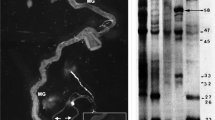Abstract
Phenol oxidase exists in Drosophila hemolymph as a prophenol oxidase, A1 and A3, that is activated in vivo with a native activating system, AMM-1, by limited proteolysis with time. The polypeptide in purified prophenol oxidase A3 has a molecular weight of approximately 77,000 Da. A PCR-based cDNA sequence coding A3 has 2501 bp encoding an open reading frame of 682 amino acid residues. The potential copper-binding sites, from Trp-196 to Tyr-245, and from Asn-366 to Phe-421, are highly homologous to the corresponding sites in other invertebrates. The availability of prophenol oxidase cDNA should be useful in revealing the biochemical differences between A1 and A3 isoforms in Drosophila melanogaster that are refractory or unable to activate prophenol oxidase.
Similar content being viewed by others
References
Asada, N. (1997). Genetic variants affecting phenol oxidase activity in Drosophila melanogaster. Biochem. Genet. 35:41.
Asada, N. (1998). Reversible activation of prophenoloxidase with 2–propanol in Drosophila melanogaster. J. Exp. Zool. 282:28.
Asada, N., Fujimoto, K., Tanaka, M., & Ohnishi, E. (1993) Genetic polymorphism of prophenoloxidase A1 in Drosophila melanogaster. Jpn. J. Genet. 68:219.
Asada, N., & Sezaki, H. (1999) Properties of phenoloxidase generated from prophenoloxidase with 2–propanol and the natural activator in Drosophila melanogaster. Biochem. Genet. 37: 149.
Ashida, M., & Brey, P. T. (1997). Recent advances in prophenoloxidase research. In Brey, P. T., & Hultmark, D. (eds.), Molecular Mechanisms of the Insect Immune Response, Chapman and Hall, London, p. 135.
Ashida, M., & Yamazaki, H. I. (1990). Biochemistry of the phenoloxidase system in insects: With special reference to its activation. In Ohnishi, E., & Ishizaki, H. (eds.), Molting and Metamorphosis, Japan Scientific Societies Press, Tokyo, p. 239.
Aspan, A., Huang, T. S., Cerenius, L., & Söderhäll, K. (1995). cDNA cloning of a prophenoloxidase from the freshwater crayfish Pacifastacus leniusculus and its activation. Proc. Natl. Acad. Sci. U.S.A. 92:936.
Chase, M. R., Raina, K., Bruno, J., & Sugumaran, M. (2000). Purification, characterization and molecular cloning of prophenol oxidase from Sarcophaga bullata. Insect Biochem. Mol. Biol. 30:853.
Cherqui, A., Duvic, B., & Breherin, M. (1996). Purification and characterization of prophenoloxidase from the hemolymph of Locusta migratoria. Arch. Insect Biochem. Physiol. 32:225.
Chomchzynsky, P., & Sacchi, N. (1987). Modified isolation for Manduca epidermis. Anal. Biochem. 162:156.
Chosa, N., Fukumitsu, T., Fujimoto, K., & Ohnishi, E. (1997). Activation of prophenol oxidase A1 by an activating enzyme in Drosophila melanogaster. Insect Biochem. Mol. Biol. 27:61.
Cui, L., Luckhart, S., & Rosenberg, R. (2000). Molecular characterization of prophenoloxidase cDNA from the malaria mosquito Anopheles stephensi. Insect Mol. Biol. 9:127.
Fujimoto, K., Masuda, K., Asada, N., & Ohnishi, E. (1993). Purification and characterization of prophenoloxidases from pupae of Drosophila melanogaster. J. Biochem. 113:285.
Fujimoto, K., Okino, N., Kawabata, S., Iwanaga, S., & Ohnishi, E. (1995). Nucleotide sequence of the cDNA encoding the proenzyme of phenol oxidase A1 of Drosophila melanogaster. Proc. Natl. Acad. Sci. U.S.A. 92:7769.
Hall, M., Scott, T., Sugumaran, M., Söderhäll, K., & Law, J. H. (1995). Proenzyme of Manduca sexta phenol oxidase: Purification, activation, substrate specificity of the active enzyme, and molecular cloning. Proc. Natl. Acad. Sci. U.S.A. 92:7764.
Hirano, H., Komatsu, S., Takakura, H., Sakiyama, F., & Tsunasawa, S. (1992). Deblocking and subsequence analysis of Na-blocked proteins electroblotted onto PVDF membrane. J. Biochem. 111:754.
Jiang, H., Wang, Y., Ma, C., & Kanost, M. R. (1997). Subunit composition of pro-phenol oxidase from Manduca sexta: Molecular cloning of subunit proPO-P1. Insect Biochem. Mol. Biol. 27: 835.
Kawabata, T., Yasuhara, Y., Ochiai, M., Matsuura, S., & Ashida, M. (1995). Molecular cloning of insect pro-phenol oxidase: A copper-containing protein homologous to arthropod hemocyanin. Proc. Natl. Acad. Sci. U.S.A. 92:7774.
Laemmli, U. K. (1970). Cleavage of structural proteins during the assembly of the head of bacteriophage T4. Nature 227:680.
Lee, H. S., Cho, M. Y., Lee, K. M., Kwon, T. M., Homma, K., Nutria, S., & Lee, B. L. (1999). The pro-phenol oxidase of coleopteran insect, Tenebrio molitor, larvae was activated during cell climp/cell adhesion if insect cellular defense reactions. FEBS Lett. 444:255.
Ohnishi, E. (1953). Tyrosinase activity during puparium formation in Drosophila melanogaster. Jpn. J. Zool. 11:69.
Park, D. S., Shin, S. W., Kim, M. G., Park, S. S., Lee, W. J., Brey, P. T., & Park, H. Y. (1997). Isolation and characterization of the cDNA encoding the prophenoloxidase of fall webworm, Hypantria cunea. Insect Biochem. Mol. Biol. 27:983.
Rizki, T. M., Rizki, R. M., & Bellotti, R. A. (1985). Genetics of Drosophila phenoloxidase. Mol. Gen. Genet. 201:7.
Sambrook, J., Fritsh, E. F., & Maniatis, T. (1989). Molecular Cloning: A Laboratory Manual, 2nd edn., Cold Spring Harbor Laboratory Press, Cold Spring Harbor, NY.
Sanger, F., Nicklen, S., & Coulson, A. R. (1977). DNA sequencing with chain-terminating inhibitors. Proc. Natl. Acad. Sci. U.S.A. 74:5463.
Sezaki, H., Kawamoto, N., & Asada, N. (2001). Effect of ionic concentration on the higher-order structure of prophenol oxidase in Drosophila melanogaster. Biochem. Genet. 39:50.
Söderhäll, K., Cerenius, L., & Johanson, M. W. (1996). The prophenoloxidase activating system in invertebrates. In Soderhall, K., Iwanaga, S., & Vasta, G. R. (eds.), New Directions in Invertebrate Immunology, SOS Publications, Fair Haven, NJ.
Sugumaran, M. (1996). Role of insect cuticle in immunity. In Soderhall, K., Iwanaga, S., & Vasta, G. R. (eds.), New Directions in Invertebrate Immunology, SOS Publications, Fair Haven, NJ.
Tsunasawa, S., Takakura, H., & Sakiyama, F. (1990). The amino acid sequence of S-antigen: N-terminus and uvenitogenic peptides. J. Protein Chem. 9:256.
Yonemura, M., Kasatani, K., Asada, N., & Ohnishi, E. (1991). Involvement of a serine protease in the activation of prophenoloxidase in Drosophila melanogaster. Zool. Sci. 8:865.
Rights and permissions
About this article
Cite this article
Asada, N., Yokoyama, G., Kawamoto, N. et al. Prophenol Oxidase A3 in Drosophila melanogaster: Activation and the PCR-Based cDNA Sequence. Biochem Genet 41, 151–163 (2003). https://doi.org/10.1023/A:1023325610300
Issue Date:
DOI: https://doi.org/10.1023/A:1023325610300




